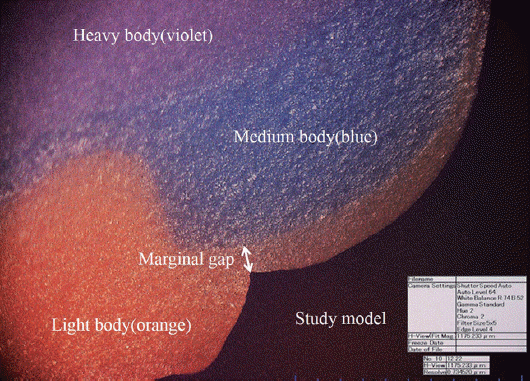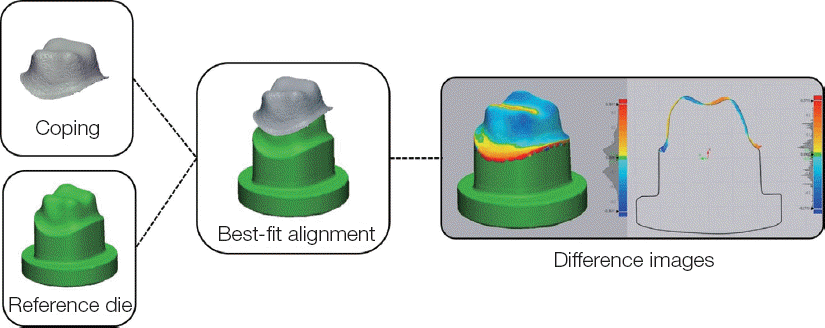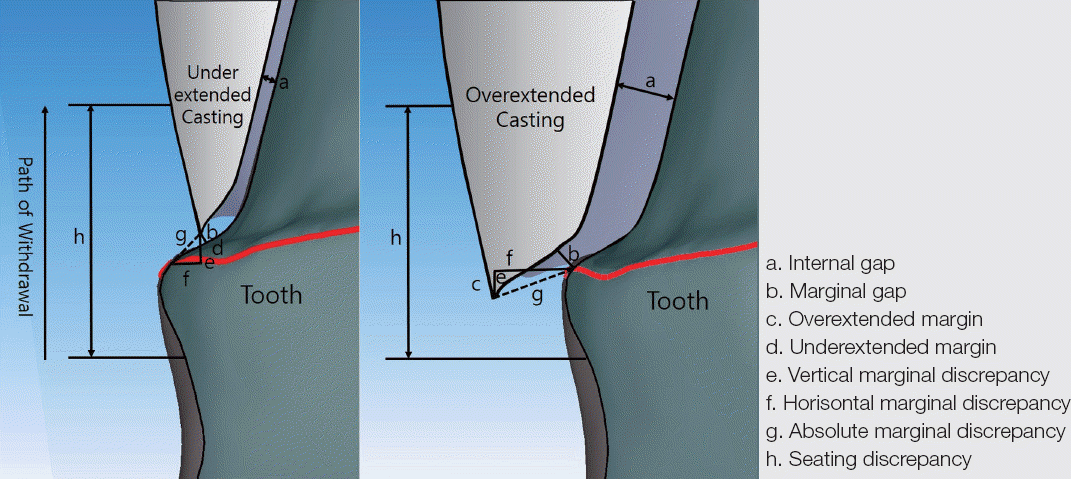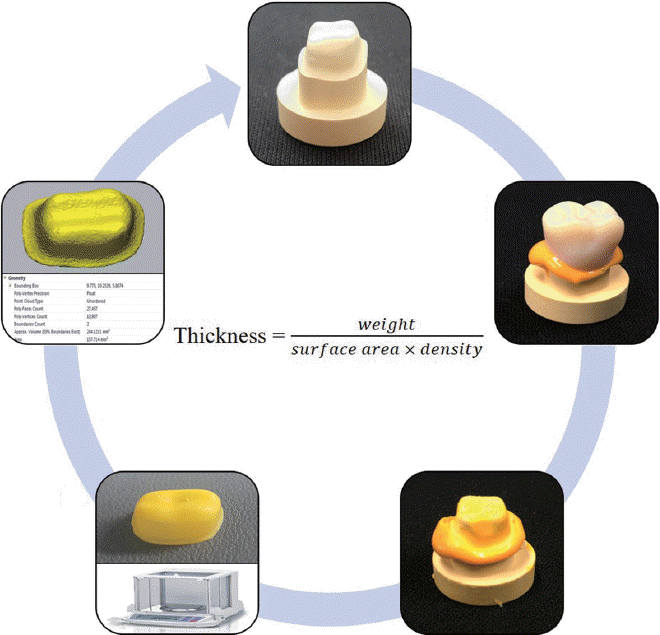1. Kim MY, Lee KW, Moon HS, Chung MK. A study on the gratification of the patient in the Dental Hospital. J Korean Acad Prosthodont. 2008; 46:6582. PMID:
8349002.
2. Rekow ED. High-technology innovations-and limitationsfor restorative dentistry. Dent Clin North Am. 1993; 37:513–24.
3. Hung SH, Hung KS, Eick JD, Chappell RP. Marginal fit of porcelain-fused-to-metal and two types of ceramic crown. J Prosthet Dent. 1990; 63:26–31. DOI:
10.1016/0022-3913(90)90260-J.
4. Schwartz NL, Whitsett LD, Berry TG, Stewart JL. Unserviceable crowns and fixed partial dentures:life-span and causes for loss of serviceability. J Am Dent Assoc. 1970; 81:1395–401. DOI:
10.14219/jada.archive.1970.0398. PMID:
5273607.
5. Grasso JE, Nalbandian J, Sanford C, Bailit H. Effect of restoration quality on periodontal health. J Prosthet Dent. 1985; 53:14–9. DOI:
10.1016/0022-3913(85)90056-3.
6. Holmes JR, Bayne SC, Holland GA, Sulik WD. Considerations in measurement of marginal fit. J Prosthet Dent. 1989; 62:405–8. DOI:
10.1016/0022-3913(89)90170-4.
7. Suárez MJ, González de Villaumbrosia P, Pradíes G, Lozano JF. Comparison of the marginal fit of Procera AllCeram crowns with two finish lines. Int J Prosthodont. 2003; 16:229–32.
8. Pelekanos S, Koumanou M, Koutayas SO, Zinelis S, Eliades G. Micro-CT evaluation of the marginal fit of different In-Ceram alumina copings. Eur J Esthet Dent. 2009; 4:278–92.
10. Sorensen SE, Larsen IB, Jörgensen KD. Gingival and alveolar bone reaction to marginal fit of subgingival crown margins. Scand J Dent Res. 1986; 94:109–14. DOI:
10.1111/j.1600-0722.1986.tb01373.x.
11. Assif D, Rimer Y, Aviv I. The flow of zinc phosphate cement under a full-coverage restoration and its effect on marginal adaptation according to the location of cement application. Quitessence Int. 1987; 18:765–74.
12. McLean JW, von Fraunhofer JA. The estimation of cement film thickness by an in vivo technique. Br Dent J. 1971; 131:107–11. DOI:
10.1038/sj.bdj.4802708.
13. McLean JW. Polycarboxylate cements. Five years’experience in general practice. Br Dent J. 1972; 132:9–15. DOI:
10.1038/sj.bdj.4802795.
15. Tuntiprawon M, Wilson PR. The effect of cement thickness on the fracture strength of all-ceramic crowns. Aust Dent J. 1995; 40:17–21. DOI:
10.1111/j.1834-7819.1995.tb05607.x.
16. Jorgensen KD, Esbensen AL. The relationship between the film thickness of zinc phosphate cement and the retention of veneer crowns. Acta Odontol Scand. 1968; 26:169–75. DOI:
10.3109/00016356809026130.
17. Passon C, Lambert RH, Lambert RL, Newman S. The effect of multiple layers of die-spacer on crown retention. Oper Dent. 1992; 17:42–9.
19. Molin MK, Karlsson SL, Kristiansen MS. Influence of film thickness on joint bend strength of a ceramic/resin composite joint. Dent Mater. 1996; 12:245–9. DOI:
10.1016/S0109-5641(96)80030-3.
20. Kunii J, Hotta Y, Tamaki Y, Ozawa A, Kobayashi Y, Fugishima A, Miyazaki T, Fujiwara T. Effect of sintering on the marginal and internal fit of CAD/CAM-fabricated zirconia frameworks. Dent Mater J. 2007; 26:820–6. DOI:
10.4012/dmj.26.820. PMID:
18203487.
21. Mitchell CA, Pintado MR, Douglas WH. Nondestructive, in vitro quantification of crown margins. J Prosthet Dent. 2001; 85:575–84. DOI:
10.1067/mpr.2001.114268. PMID:
11404758.
22. Shearer B, Gough MB, Setchell DJ. Influence of marginal configuration and porcelain addition on the fit of In-Ceram crowns. Biomaterials. 1996; 17:1891–5. DOI:
10.1016/0142-9612(95)00302-9.
23. Rahme HY, Tehini GE, Adib SM, Ardo AS, Rifai KT. In vitro evaluation of “replica technique” in the measurement of the fit of Procera crowns. J Contemp Dent Pract. 2008; 9:25–32.
24. Tsitrou EA, Northeast SE, van Noort R. Evaluation of the marginal fit of three margin designs of resin composite crowns using CAD/CAM. J Dent. 2007; 35:68–73. DOI:
10.1016/j.jdent.2006.04.008. PMID:
16781043.
25. Tjan AH, Li T, Logan GI, Baum L. Marginal accuracy of complete crowns made from alternative casting alloys. J Prosthet Dent. 1991; 66:157–64. DOI:
10.1016/S0022-3913(05)80041-1.
26. Stappert CF, Dai M, Chitmongkolsuk S, Gerds T, Strub JR. Marginal adaptation of three-unit fixed partial dentures constructed from pressed ceramic systems. Br Dent J. 2004; 196:766–70. DOI:
10.1038/sj.bdj.4811390. PMID:
15220983.
27. Wolfart S, Wegner SM, Al-Halabi A, Kern M. Clinical evaluation of marginal fit of a new experimental all-ceramic system before and after cementation. Int J Prosthodont. 2003; 16:587–92.
28. Okutan M, Heydecke G, Butz F, Strub JR. Fracture load and marginal fit of shrinkage-free ZrSiO4 allceramic crowns after chewing simulation. J Oral Rehabil. 2006; 33:827–32. DOI:
10.1111/j.1365-2842.2006.01637.x. PMID:
17002742.
29. Att W, Komine F, Gerds T, Strub JR. Marginal adaptation of three different zirconium dioxide three-unit fixed dental prostheses. J Prosthet Dent. 2009; 101:239–47. DOI:
10.1016/S0022-3913(09)60047-0.
30. Tinschert J, Natt G, Mautsch W, Spiekermann H, Anusavice KJ. Marginal fit of alumina- and zirconia-based fixed partial dentures produced by a CAD/CAM system. Oper Dent. 2001; 26:367–74.
31. Beschnidt SM, Strub JR. Evaluation of the marginal accuracy of different all-ceramic crown systems after simulation in the artificial mouth. J Oral Rehabil. 1999; 26:582–93. DOI:
10.1046/j.1365-2842.1999.00449.x.
32. Kern M, Schaller HG, Strub JR. Marginal fit of restorations before and after cementation in vivo. Int J Prosthodont. 1993; 6:585–91.
33. Assif D, Antopolski B, Helft M, Kaffe I. Comparison of methods of clinical evaluation of the marginal fit of complete cast gold crowns. J Prosthet Dent. 1985; 54:20–4. DOI:
10.1016/S0022-3913(85)80062-7.
34. Groten M, Axmann D, Pröbster L, Weber H. Determination of the minimum number of marginal gap measurements required for practical in-vitro testing. J Prosthet Dent. 2000; 83:40–9. DOI:
10.1016/S0022-3913(00)70087-4.
35. Luthardt RG, Bornemann G, Lemelson S, Walter MH, Hüls A. An innovative method for evaluation of the 3-D internal fit of CAD/CAM crowns fabricated after direct optical versus indirect laser scan digitizing. Int J Prosthodont. 2004; 17:680–5.
36. Moldovan O, Luthardt RG, Corcodel N, Rudolph H. Three-dimensional fit of CAD/CAM-made zirconia copings. Dent Mater. 2011; 27:1273–8. DOI:
10.1016/j.dental.2011.09.006. PMID:
21983002.
37. Kim KB, Kim JH, Kim WC, Kim HY, Kim JH. Evaluation of the marginal and internal gap of metal-ceramic crown fabricated with a selective laser sintering technology:two- and threedimensional replica techniques. J Adv Prosthodont. 2013; 5:179–86. DOI:
10.4047/jap.2013.5.2.179. PMID:
23755345. PMCID:
PMC3675292.
38. Coli P, Karlsson S. Fit of a new pressure-sintered zirconium dioxide coping. Int J Prosthodont. 2004; 17:59–64.
39. Laurent M, Scheer P, Dejou J, Laborde G. Clinical evaluation of the marginal fit of cast crowns-validation of the silicon replica method. J Oral Rehabil. 2008; 35:116–22. DOI:
10.1111/j.1365-2842.2003.01203.x. PMID:
18197844.
40. Kim JH, Kim KB. Evaluation of dimensional stability of digital dental model fabricated by impression scanning method. J Dent Hyg Sci. 2014; 14:1521.
41. DeLong R, Heinzen M, Hodges JS, Ko CC, Douglas WH. Accuracy of a system for creating 3D computer models of dental arches. J Dent Res. 2003; 82:438–42. DOI:
10.1177/154405910308200607. PMID:
12766195.
42. Bae SY, Park JY, Jeong ID, Kim JH, Kim WC. Three-dimensional analysis of marginal and internal fit of copings fabricated with polyetherketoneketone (PEKK) and zirconia. J Prosthodont Res. 2017; 61:106–12. DOI:
10.1016/j.jpor.2016.07.005. PMID:
27484816.
43. Schaefer O, Watts DC, Sigusch BW, Kuepper H, Guentsch A. Marginal and internal fit of pressed lithium disilicate partial crowns in vitro:a three-dimensional analysis of accuracy and reproducibility. Dent Mater. 2012; 28:320–6. DOI:
10.1016/j.dental.2011.12.008. PMID:
22265824.
44. Kim KB, Jung JK, Kim JH. Accuracy of digital impression made from different elastomeric impression materials:three-dimensional superimpositional analysis. J Dent Hyg Sci. 2014; 14:94–100.
45. Nakamura T, Dei N, Kojima T, Wakabayashi K. Marginal and internal fit of Cerec 3 CAD/CAM all-ceramic crowns. Int J Prosthodont. 2003; 16:2448.
46. Lee KB, Park CW, Kim KH, Kwon TY. Marginal and internal fit of all-ceramic crowns fabricated with two different CAD/CAM systems. Dent Mater J. 2008; 27:422–6. DOI:
10.4012/dmj.27.422. PMID:
18717171.
47. Colpani JT, Borba M, Della Bona A. Evaluation of marginal and internal fit of ceramic crown copings. Dent Mater. 2013; 29:174–80. DOI:
10.1016/j.dental.2012.10.012. PMID:
23218747.
49. Seo D, Yi Y, Roh B. The effect of preparation designs on the marginal and internal gaps in Cerec3 partial ceramic crowns. J Dent. 2009; 37:374–82. DOI:
10.1016/j.jdent.2009.01.008. PMID:
19282083.
50. Alfaro DP, Ruse ND, Carvalho RM, Wyatt CC. Assessment of the internal fit of lithium disilicate crowns using micro-CT. J Prosthodont. 2015; 24:381–6. DOI:
10.1111/jopr.12274. PMID:
25753858.
51. Rungruanganunt P, Kelly JR, Adams DJ. Two imaging techniques for 3D quantification of precementation space for CAD/CAM crowns. J Dent. 2010; 38:995–1000. DOI:
10.1016/j.jdent.2010.08.015. PMID:
20801185.
52. Kim JH, Jeong JH, Lee JH, Cho HW. Fit of lithium disilicate crowns fabricated from conventional and digital impressions assessed with micro-CT. J Prosthet Dent. 2016; 116:551–7. DOI:
10.1016/j.prosdent.2016.03.028. PMID:
27422237.
53. Nawafleh NA, Mack F, Evans J, Mackay J, Hatamleh MM. Accuracy and reliability of methods to measure marginal adaptation of crowns and FDPs:a literature review. J Prosthodont. 2013; 22:419–28. DOI:
10.1111/jopr.12006. PMID:
23289599 .







 PDF
PDF Citation
Citation Print
Print





 XML Download
XML Download